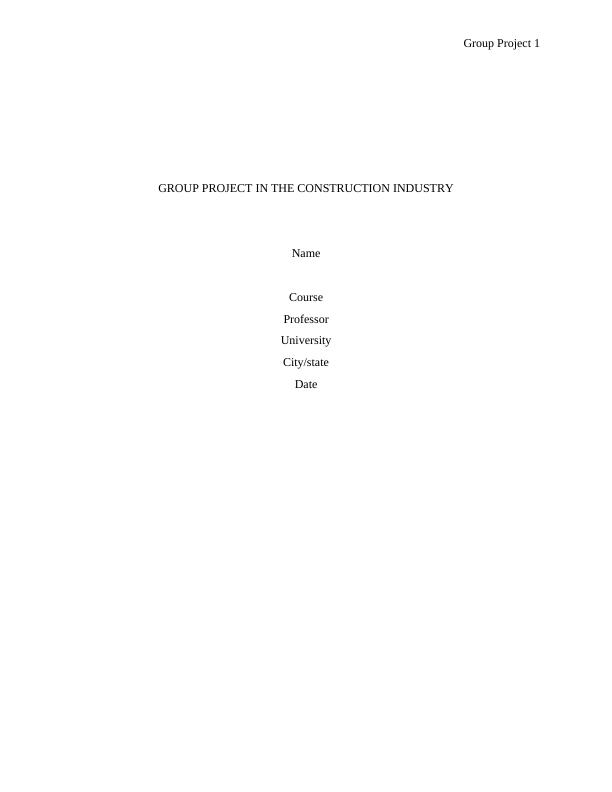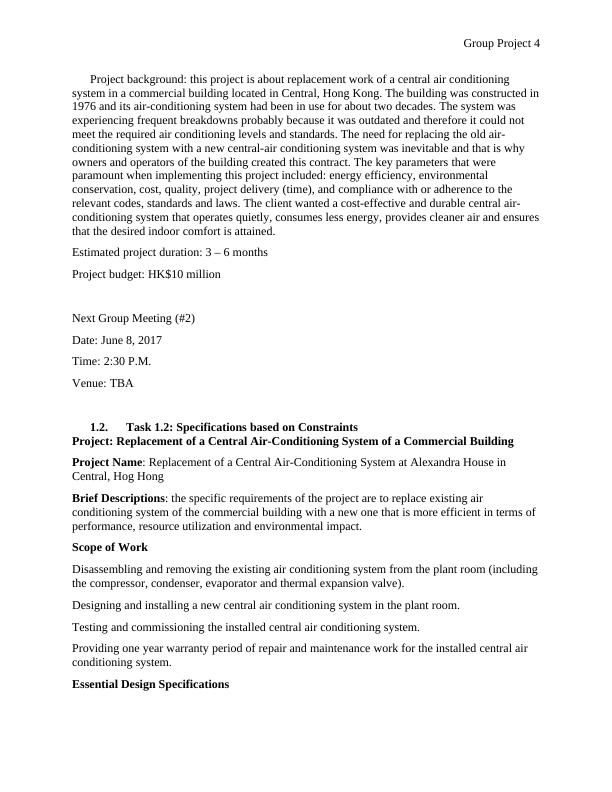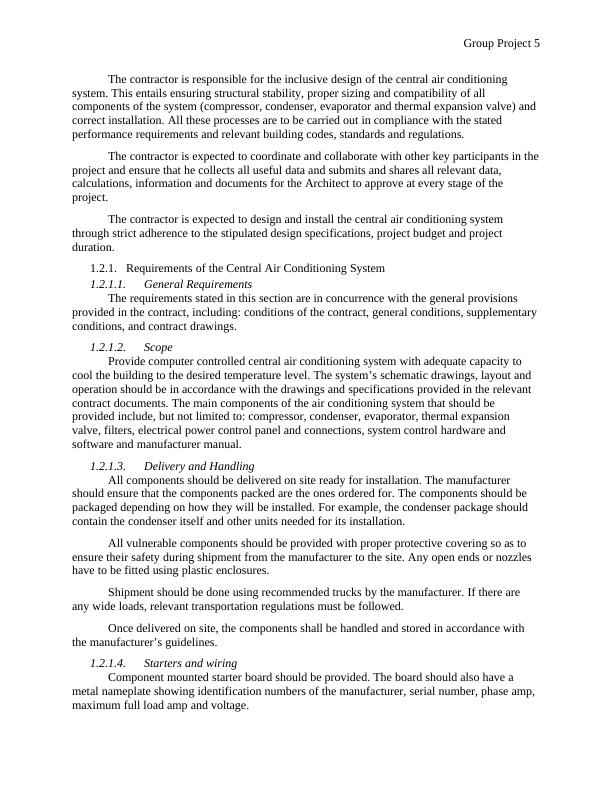Group Project in the Construction Industry
33 Pages11099 Words53 Views
Hong Kong College Of Engineering
Added on 2020-02-24
Group Project in the Construction Industry
Hong Kong College Of Engineering
Added on 2020-02-24
ShareRelated Documents
Group Project 1GROUP PROJECT IN THE CONSTRUCTION INDUSTRYNameCourseProfessorUniversityCity/stateDate

Group Project 2Table of Contents1.Task 1.................................................................................................................................................21.1.Task 1.1: Group roles and activities.........................................................................................21.2.Task 1.2: Specifications based on Constraints.........................................................................41.2.1.Requirements of the Central Air Conditioning System........................................................51.2.2.Products...............................................................................................................................81.3.Initial proposals.......................................................................................................................111.3.1.Proposal 1..........................................................................................................................111.3.2.Proposal 2..........................................................................................................................131.3.3.Comparison of the existing and proposed systems.............................................................152.Task 2...............................................................................................................................................162.1.Task 2.1: Evidence of project development...........................................................................162.2.Task 2.2: Final design proposal that meets the desired specifications.................................202.2.1.Essential Design Specifications.........................................................................................212.2.2.Water-cooled chiller...........................................................................................................213.Task 3...............................................................................................................................................273.1.Task 3.1: Project evaluation and recommendations for improvement................................273.1.1.Proposal 3..........................................................................................................................274.Task 4...............................................................................................................................................294.1.Task 4.1: Project development records..................................................................................29References................................................................................................................................................33

Group Project 31.Task 11.1.Task 1.1: Group roles and activitiesProject members: Chan Nai Tat, Wong Wai and Chan MingFirst Group Meeting (#1)Date: June 5, 2017Time: 2:30 P.M.Venue: TBAMembers present:Chan Nai TatWong WaiChan MingMeeting agenda:1.Deliberation on the project goals and objectives 2.Role of each group member in relation to the project3.Scope of work for each group member4.Expected code of conduct for all group members Meeting proceedings:1.Group structureTeam leader – Chan Nai TatTeam member – Wong WaiTeam member – Chan Ming2.ResponsibilitiesChan Nai Tat (team leader) – responsible for tendering process, prepare project program, track progress of the project and provide guidance on way forward, ensure collaboration and cooperation of members, resolve any disputes between members and call for meetings.Wong Wai (team member) – responsible for establishing the desired specifications for various components and processes of the project, develop necessary drawings, prepare relevant documents, compile reports, write minutes during meetings and keep records of all ongoing activities.Chan Ming (team member) – responsible for carrying out site survey, facilitating coordination with subcontractors and coordinating and monitoring works performed by subcontractors on site.3.Project plan discussion

Group Project 4Project background: this project is about replacement work of a central air conditioning system in a commercial building located in Central, Hong Kong. The building was constructed in1976 and its air-conditioning system had been in use for about two decades. The system was experiencing frequent breakdowns probably because it was outdated and therefore it could not meet the required air conditioning levels and standards. The need for replacing the old air-conditioning system with a new central-air conditioning system was inevitable and that is why owners and operators of the building created this contract. The key parameters that were paramount when implementing this project included: energy efficiency, environmental conservation, cost, quality, project delivery (time), and compliance with or adherence to the relevant codes, standards and laws. The client wanted a cost-effective and durable central air-conditioning system that operates quietly, consumes less energy, provides cleaner air and ensuresthat the desired indoor comfort is attained.Estimated project duration: 3 – 6 monthsProject budget: HK$10 millionNext Group Meeting (#2)Date: June 8, 2017 Time: 2:30 P.M.Venue: TBA1.2.Task 1.2: Specifications based on ConstraintsProject: Replacement of a Central Air-Conditioning System of a Commercial BuildingProject Name: Replacement of a Central Air-Conditioning System at Alexandra House in Central, Hog HongBrief Descriptions: the specific requirements of the project are to replace existing air conditioning system of the commercial building with a new one that is more efficient in terms of performance, resource utilization and environmental impact.Scope of WorkDisassembling and removing the existing air conditioning system from the plant room (includingthe compressor, condenser, evaporator and thermal expansion valve).Designing and installing a new central air conditioning system in the plant room. Testing and commissioning the installed central air conditioning system.Providing one year warranty period of repair and maintenance work for the installed central air conditioning system.Essential Design Specifications

Group Project 5The contractor is responsible for the inclusive design of the central air conditioning system. This entails ensuring structural stability, proper sizing and compatibility of all components of the system (compressor, condenser, evaporator and thermal expansion valve) and correct installation. All these processes are to be carried out in compliance with the stated performance requirements and relevant building codes, standards and regulations. The contractor is expected to coordinate and collaborate with other key participants in theproject and ensure that he collects all useful data and submits and shares all relevant data, calculations, information and documents for the Architect to approve at every stage of the project.The contractor is expected to design and install the central air conditioning system through strict adherence to the stipulated design specifications, project budget and project duration. 1.2.1.Requirements of the Central Air Conditioning System1.2.1.1.General RequirementsThe requirements stated in this section are in concurrence with the general provisions provided in the contract, including: conditions of the contract, general conditions, supplementaryconditions, and contract drawings.1.2.1.2.ScopeProvide computer controlled central air conditioning system with adequate capacity to cool the building to the desired temperature level. The system’s schematic drawings, layout and operation should be in accordance with the drawings and specifications provided in the relevant contract documents. The main components of the air conditioning system that should be provided include, but not limited to: compressor, condenser, evaporator, thermal expansion valve, filters, electrical power control panel and connections, system control hardware and software and manufacturer manual.1.2.1.3.Delivery and HandlingAll components should be delivered on site ready for installation. The manufacturer should ensure that the components packed are the ones ordered for. The components should be packaged depending on how they will be installed. For example, the condenser package should contain the condenser itself and other units needed for its installation.All vulnerable components should be provided with proper protective covering so as to ensure their safety during shipment from the manufacturer to the site. Any open ends or nozzles have to be fitted using plastic enclosures.Shipment should be done using recommended trucks by the manufacturer. If there are any wide loads, relevant transportation regulations must be followed.Once delivered on site, the components shall be handled and stored in accordance with the manufacturer’s guidelines.1.2.1.4.Starters and wiringComponent mounted starter board should be provided. The board should also have a metal nameplate showing identification numbers of the manufacturer, serial number, phase amp, maximum full load amp and voltage.

Group Project 61.2.1.5.Control interfaceEvery component should have an integrated control unit that will be connected to the component on site to ensure accurate and continuous monitoring and control of the component’s operation. 1.2.1.6.InstallationAll components should be installed to enable efficient operation, and easy and safe maintenance. Grease fittings should be fixed directly to bearings except if the bearings are not easily reached. In cases where bearings are not easily reached or visible, the contractor shall haveto provide reachable extensions to lubrication fittings of the bearings. The arrangement of the entire system should be in accordance with the specified physical layout. The valves should be strategically located to enable isolation and removal of any component without having to completely drain the liquid or refrigerant circuits. 1.2.1.7.FinishAll components should be factory painted according to the recommendations of the manufacturer for those that are exposed to the environment of industry activity. If necessary, the components shall also be painted on site by following the architect’s instructions.1.2.1.8.Service tools and sideboardComplete set of apparatuses and tools for maintenance and servicing of the system in metal sideboard with appropriate tagging should also be provided.Contract duration: 90 – 180 daysContract cost: HK$10 million1.2.1.9.Standard drawingSchematic drawing of the central air conditioning system (chiller) is as shown in Figure 1 and 2 belowFigure 1: Schematic drawing of water-cooled chiller

Group Project 7Figure 2: Schematic drawing of the central air conditioning system1.2.1.10.ConstraintsThroughout the construction period, tenants of the building should not be affected. This means that the air conditioning system should not stop working and the contractor should provide adequate cool air for supply in the building. Noises emanating from ongoing construction activities should not cause disturbance to the tenants. Also, transportation of materials and equipment to the site should only be done from 10:00 A.M. to 11:00 A.M., 1:00 P.M. to 2:30 P.M. or during the night starting from 7:00 P.M.1.2.1.11.Project acceptanceThe project shall be accepted by following the acceptance criteria provided in various relevant standards. These include: BEEO – Building Energy Efficiency Ordinance (the Ordinance), General Specification for Air-Conditioning Refrigeration, Ventilation and Central Monitoring & Control System Installation, Building Energy Codes and the Code of Practice for Energy Efficiency of Air Conditioning Installations.

Group Project 81.2.2.Products1.2.2.1.ManufacturersAll components supplied shall only be accepted if they are from the specified manufacturer, meet the minimum industry standards, comply with the specifications provided in the contract documents and meet the stipulated performance requirements. But if there is any other alternative component used that is not from the specified manufacturer, it will be the responsibility of the mechanical contractor to coordinate with the general contractor and other relevant subcontractors to ensure that appropriate installation process is followed so that there is appropriate compatibility between all the components installed. The alternative components should also conform to the following requirements: meet the minimum industry standards, comply with the specifications provided in the contract documents and meet the stipulated performance requirements. During coordination for this purpose, the following factors shall be considered: structural supports and integrity of the components; size, layout and sturdiness of thecondenser, evaporator, compressor and expansion valve; connection points and size of connection pipes; electrical power supplies, electrical supply pipe sizes and overcurrent shields; site noises during installation; and any other physical constraints. Any costs incurred by consultants, the general contractor and subcontractors when changing the building provisions so as to accommodate the alternative components shall be paid by the mechanical contractor. The manufacturer selected for this project should be a company specialized in the design and production of the specified components and products and is required to have a minimum experience of 5 years, manufacturing and supplying central air conditioning systems that is specified in the contract documents.1.2.2.2.General Description:Design, install, test, commission and maintain a factory assembled central air conditioning system as specified and validated in the drawings. The whole system entails, but notlimited to: water-cooled shell & tube condenser, shell & tube type evaporator (including blower or air handler and evaporator coil), hermetic screw compressor, expansion valve, electrical supply panel, supply and return pipes, refrigerant circuits, refrigerant, wiring cables, operating and safety controls, system control hardware and software, etc. The components should have all the specified performance characteristics and relevant security features.Operating characteristics:The central air conditioning system should have the capacity to provide high and low ambient temperature control options and operate with the ambient temperature ranging from -10 °C to 25 °C. The system should be able to vary its working capacity so as to adjust cooling capacity depending on cooling load. Sideboard:Structural elements, component panels, structural bases of heavy equipment and control boxes should be made of factory coated galvanized steel. Exposed steel panel should be painted with seared powder paint so as to pass the 500-hour salt spray check.

End of preview
Want to access all the pages? Upload your documents or become a member.
Related Documents
Replace Air-conditioning System in 20 Storey Commercial Building : Projectlg...
|34
|8917
|107
Replacing Air Conditioning System in 20 Storey Commercial Buildinglg...
|19
|1508
|423
Group Project: Roles and Responsibilities for Reusing Materials in Building Demolition Siteslg...
|35
|10766
|92
VoIP/G-suite Projectlg...
|11
|1440
|128
Assignment On Implementation Of Erp System For Jyotiviclg...
|15
|2297
|20
Australian Engineering Practicelg...
|10
|3445
|29
